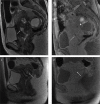Shining light in a dark landscape: MRI evaluation of unusual localization of endometriosis
- PMID: 28703103
- PMCID: PMC5508950
- DOI: 10.5152/dir.2017.16364
Shining light in a dark landscape: MRI evaluation of unusual localization of endometriosis
Abstract
Endometriosis is a disease distinguished by the presence of endometrial tissue outside the uterine cavity with intralesional recurrent bleeding and resulting fibrosis. The most common locations for endometriosis are the ovaries, pelvic peritoneum, uterosacral ligaments, and torus uterinus. Typical symptoms are secondary dysmenorrhea and cyclic or chronic pelvic pain. Unusual sites of endometriosis may be associated with specific symptoms depending on the localization. Atypical pelvic endometriosis localizations can occur in the cervix, vagina, round ligaments, ureter, and nerves. Moreover, rare extrapelvic endometriosis implants can be localized in the upper abdomen, subphrenic fold, or in the abdominal wall. Magnetic resonance imaging (MRI) represents a problem-solving tool among other imaging modalities. MRI is an advantageous technique, because of its multiplanarity, high contrast resolution, and lack of ionizing radiation. Our purpose is to remind the radiologists the possibility of atypical pelvic and extrapelvic endometriosis localizations and to illustrate the specific MRI findings. Endometriotic tissue with hemorrhagic content can be distinguished from adherences and fibrosis on MRI imaging. Radiologists should keep in mind these atypical localizations in patients with suspected endometriosis, in order to achieve the diagnosis and to help the clinicians in planning a correct and complete treatment strategy.
Conflict of interest statement
The authors declared no conflicts of interest.
Figures











Comment in
-
Endometrioma of the sigmoid colon presenting with intestinal obstruction.Diagn Interv Radiol. 2018 Jan-Feb;24(1):60-61. doi: 10.5152/dir.2017.17274. Diagn Interv Radiol. 2018. PMID: 29199174 Free PMC article. No abstract available.
-
Author's Reply.Diagn Interv Radiol. 2018 Jan-Feb;24(1):60-61. doi: 10.5152/dir.2017.001. Diagn Interv Radiol. 2018. PMID: 29199175 Free PMC article. No abstract available.
Similar articles
-
Atypical Sites of Deeply Infiltrative Endometriosis: Clinical Characteristics and Imaging Findings.Radiographics. 2018 Jan-Feb;38(1):309-328. doi: 10.1148/rg.2018170093. Radiographics. 2018. PMID: 29320327 Review.
-
MR imaging of endometriosis: Spectrum of disease.Diagn Interv Imaging. 2017 Nov;98(11):751-767. doi: 10.1016/j.diii.2017.05.009. Epub 2017 Jun 23. Diagn Interv Imaging. 2017. PMID: 28652096 Review.
-
Deep pelvic endometriosis: don't forget round ligaments. Review of anatomy, clinical characteristics, and MR imaging features.Abdom Imaging. 2014 Jun;39(3):622-32. doi: 10.1007/s00261-014-0091-3. Abdom Imaging. 2014. PMID: 24557639 Review.
-
Encyclopedia of endometriosis: a pictorial rad-path review.Abdom Radiol (NY). 2020 Jun;45(6):1587-1607. doi: 10.1007/s00261-019-02381-w. Abdom Radiol (NY). 2020. PMID: 31919647 Review.
-
MR imaging in deep pelvic endometriosis: a pictorial essay.Radiographics. 2011 Mar-Apr;31(2):549-67. doi: 10.1148/rg.312105144. Radiographics. 2011. PMID: 21415196 Review.
Cited by
-
Endometrioma of the sigmoid colon presenting with intestinal obstruction.Diagn Interv Radiol. 2018 Jan-Feb;24(1):60-61. doi: 10.5152/dir.2017.17274. Diagn Interv Radiol. 2018. PMID: 29199174 Free PMC article. No abstract available.
-
Endometriosis of the Round Ligaments in Twins: A Rare and Unique Presentation.J Belg Soc Radiol. 2025 Apr 16;109(1):16. doi: 10.5334/jbsr.3898. eCollection 2025. J Belg Soc Radiol. 2025. PMID: 40248836 Free PMC article.
-
A review of the MRI features of endometriosis: what should be paid attention to during the reporting process?Abdom Radiol (NY). 2025 May 29. doi: 10.1007/s00261-025-05002-x. Online ahead of print. Abdom Radiol (NY). 2025. PMID: 40439722 Review.
-
MRI of endometriosis in correlation with the #Enzian classification: applicability and structured report.Insights Imaging. 2023 Jul 5;14(1):120. doi: 10.1186/s13244-023-01466-x. Insights Imaging. 2023. PMID: 37405519 Free PMC article. Review.
-
Concordance between Preoperative #ENZIANi Score and Postoperative #ENZIANs Score Classification-Why Do We Choose #ENZIAN and How Does It Impact the Future Classification Trend?J Clin Med. 2024 Oct 9;13(19):6005. doi: 10.3390/jcm13196005. J Clin Med. 2024. PMID: 39408066 Free PMC article.
References
-
- Novellas S, Chassang M, Bouaziz J, Delotte J, Toullalan O, Chevallier EP. Anterior pelvic endometriosis: MRI features. Abdom Imaging. 2010;35:742–749. https://doi.org/10.1007/s00261-010-9600-1. - DOI - PubMed
-
- Siegelman ES, Oliver ER. MR imaging of endometriosis: ten imaging pearls. Radiographics. 2012;32:1675–1691. https://doi.org/10.1148/rg.326125518. - DOI - PubMed
-
- Coutinho A, Jr, Bittencourt LK, Pires CE, et al. MR imaging in deep pelvic endometriosis: a pictorial essay. Radiographics. 2011;31:549–567. https://doi.org/10.1148/rg.312105144. - DOI - PubMed
-
- Woodward PF, Sohaey R, Mezzetti TP. Endometriosis: radiologic–pathologic correlation. Radiographics. 2011;21:193–216. https://doi.org/10.1148/radiographics.21.1.g01ja14193. - DOI - PubMed
-
- Bennett GL, Slywotzky CM, Cantera M, Hecht EM. Unusual manifestations and complications of endometriosis--spectrum of imaging findings: pictorial review. AJR Am J Roentgenol. 2011;194:WS34–46. https://doi.org/10.2214/AJR.07.7142. - DOI - PubMed
MeSH terms
LinkOut - more resources
Full Text Sources
Other Literature Sources
Medical

